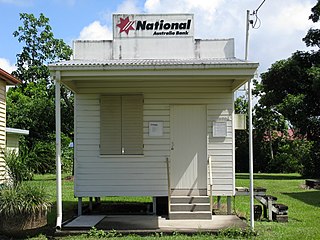
Innisfail is a regional town and locality in the Cassowary Coast Region, Queensland, Australia. The town was originally called Geraldton until 1910. In the 2016 census, the town of Innisfail had a population of 7,236 people, while the locality of Innisfail had a population of 1,145 people.

Mission Beach is a coastal town and locality in the Cassowary Coast Region, Queensland, Australia. In the 2016 census, the locality of Mission Beach had a population of 815 people.
Mundoo is a rural town and locality in the Cassowary Coast Region, Queensland, Australia. In the 2016 census the locality of Mundoo had a population of 224 people.

East Innisfail is a suburban locality in the Cassowary Coast Region, Queensland, Australia. In the 2016 census East Innisfail had a population of 1,855 people.

South Johnstone is a rural town and locality in the Cassowary Coast Region, Queensland, Australia. In the 2021 census, the locality of South Johnstone had a population of 456 people.

Silkwood is a rural town and locality in the Cassowary Coast Region, Queensland, Australia. In the 2016 census, the locality of Silkwood had a population of 391 people.

Cowley Beach is a beach, coastal town and locality in the Cassowary Coast Region, Queensland, Australia. In the 2021 census, the locality of Cowley Beach had a population of 65 people.

Goondi is a locality in the Cassowary Coast Region, Queensland, Australia.

Garners Beach is a coastal locality in the Cassowary Coast Region, Queensland, Australia. In the 2016 census, Garners Beach had a population of 25 people.
Coorumba is a rural locality in the Cassowary Coast Region, Queensland, Australia. In the 2016 census, Coorumba had a population of 121 people.

Daradgee is a rural town and locality in the Cassowary Coast Region, Queensland, Australia. In the 2016 census, Daradgee had a population of 74 people.
Wangan is a town and a locality in the Cassowary Coast Region, Queensland, Australia. In the 2021 census, the locality of Wangan had a population of 612 people.
Goondi Hill is a semi-urban locality in the Cassowary Coast Region, Queensland, Australia. In the 2016 census, Goondi Hill had a population of 510 people.
Goondi Bend is a mixed-use locality in the Cassowary Coast Region, Queensland, Australia. In the 2016 census, Goondi Bend had a population of 594 people.
Cullinane is a rural locality in the Cassowary Coast Region, Queensland, Australia. In the 2016 census, Cullinane had a population of 524 people.
Innisfail Estate is a semi-rural locality in the Cassowary Coast Region, Queensland, Australia. In the 2016 census, Innisfail Estate had a population of 1,338 people.
Goolboo is a rural locality in the Cassowary Coast Region of Queensland, Australia. In the 2021 census, Goolboo had a population of 25 people.
Currajah is a rural locality in the Cassowary Coast Region, Queensland, Australia. In the 2021 census, Currajah had a population of 57 people.
Upper Daradgee is a rural locality in the Cassowary Coast Region, Queensland, Australia. In the 2016 census, Upper Daradgee had a population of 101 people.
No. 6 Branch is a rural locality in the Cassowary Coast Region, Queensland, Australia. In the 2016 census, No. 6 Branch had a population of 50 people.









